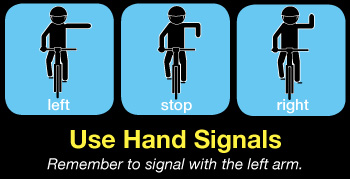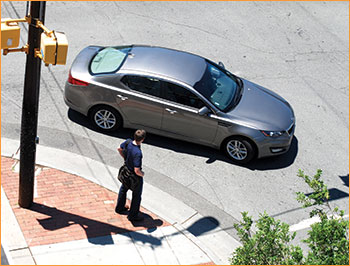>> Safety Resources
Frequently Asked Questions
- What does the law require of motorists, bicyclists and pedestrians to help ensure safety on the roads?
- Driver Laws
- Drivers are required to yield to pedestrians at marked crossings and unmarked crosswalks at intersections except where there is a traffic or pedestrian signal. (§20-155)
- Drivers must stop for pedestrians at stop signs and flashing red lights and must yield for pedestrians at flashing yellow lights. (§20-158)
- Drivers making right or left turns must allow pedestrians to cross first, unless pedestrians are prohibited from crossing. (§20-173) Pedestrians or bicyclists on sidewalks have the right of way, so drivers must let them pass before turning into or out of driveways and parking lots. (§20-173)
- State law prohibits drivers from passing vehicles stopped for pedestrians in crosswalks. (§20-173(b))
- It is incumbent upon drivers to make sure the road is clear of pedestrians before pulling forward or backing up. (§20-154)
- Changes made to §20-150(e) under Session Law 2016-90 allow a driver in a marked no passing zone to pass a bicyclist (moving in the same direction, and when the driver is not making a turn, and when safe conditions exist) if the driver provides a minimum of four feet of passing distance between the bicyclist or completely enters the left lane.
- Pedestrian Laws
- Pedestrians have the right of way at marked crossings, meaning cars must yield to pedestrians. (§20-155 and §20-173)
- State law requires pedestrians to use marked crosswalks when they are provided, and it is unlawful to cross a street outside a marked crosswalk if the pedestrian is between two signalized intersections. (§20-172)
- When NOT at an intersection or marked crosswalk, pedestrians must yield the right of way to all vehicles. (§20-174)
- At crosswalks with pedestrian signals, state law requires that pedestrians obey the “Walk” and “Don’t Walk” signs in the same way a driver must obey Red or Green lights. (§20-172)
- State law requires pedestrians walking along the road to use sidewalks when available. (§20-174)
- When sidewalks are not available, pedestrians are to walk to the far left edge of the road facing traffic. Walking in this direction gives pedestrians the best view of traffic. (§20-174)
- Bicyclist Laws
- Bicyclists must ride on the right in the same direction of traffic and a far to the right as is safe and practicable. (§20-146)
- Bicyclists must obey all traffic signs and signals. (§20-158)
- Bicyclist must use hand signals to communicate intended movements, such as turns or stops. Changes made to this general statute in 2016 allow a bicyclist to signal his or her intention to make a right turn by extending his or her hand and arm horizontally, with the forefinger pointing, from beyond the right side of the bicycle. (§20-154)
- At night, bicyclists are required to use a front lamp visible from 300 feet and a rear reflector or reflective clothing that is visible from a distance of 300 feet. (20-129; see changes under SL 2016-90)
- Bicyclists under 16 years of age must wear a bicycle helmet on public roads, public paths and public rights-of way. (§20-171.9)
- All child passengers under 40 pounds or 40 inches must be seated and secured in a child seat or bicycle trailer. (§20-171.9)
- Bicyclists being passed by a motor vehicle or another bicyclist should remain as far to the right as practicable and not increase their speed while being overtaken. (§20-149)
- Bicyclists must yield the right-of-way before entering or crossing any main-traveled or through highway if the roadway they are on is posted with a “yield right-of-way” sign. (§20-158)
- Police enforce many laws that affect safety, including red light running, speeding, and sobriety checks to prevent alcohol-related events. Most recently the police have been stepping up enforcement of laws requiring motorists to yield to pedestrians in crosswalks.
- Driver Laws
- What efforts will local police be taking to reduce pedestrian and bicyclist crashes?
- Throughout the year, and particularly in the Summer and Fall peak crash seasons, police will be stepping up enforcement activities to raise awareness of laws requiring motorists to yield to pedestrians in crosswalks, to pass cyclists safely and to assure bicyclists are using the proper signals and lighting, among other safe behaviors.
- Where will police enforcement be taking place?
- Police enforcement will be taking place throughout our partner communities. Police have worked with traffic safety researchers at UNC’s Highway Safety Research Center to identify specific hotspots where pedestrian and bicyclist safety issues exist and will concentrate efforts where they are needed most. Visit the Media page for the latest news releases and information regarding enforcement activities.
- Are police ticketing jaywalkers as part of this effort?
- Jaywalking, or walking outside of a marked crosswalk, is a term that is often misused. In many instances perceived as “jaywalking,” pedestrians may cross legally and actually have the right of way, such as at any intersection without a traffic signal, where there is an implied crossing for pedestrians. In other cases, such as if a pedestrian crosses the road at an unmarked crossing between two unsignalized intersections, it is still a legal crossing but the pedestrians must yield the right of way to all vehicles.

- It is, however, unlawful for pedestrians to cross a street outside a marked crosswalk if they are between two signalized intersections. Further, at crosswalks with pedestrian signals, state law requires that pedestrians obey the “Walk” and “Don’t Walk” signs in the same way a driver must obey Red or Green lights. As part of this effort, police and traffic safety officials will be trying to bring attention to the laws that both drivers and pedestrians must follow.
- What else are cities doing to improve pedestrian and bicyclist safety in NC?
- Many cities are using the Three-E model, addressing pedestrian and bicyclist safety through a combination of engineering, enforcement and education. Some communities are passing cell phone and texting bans to reduce driver distraction that can lead to a crash. Others are implementing Complete Streets guidelines or Vision Zero programs to ensure that all roads are designed with proper facilities to support safe pedestrian movement. Some communities are revising drivers’ education curriculum to help teach new drivers how to drive around pedestrians and bicyclists, and other communities are beginning to teach traffic safety and pedestrian safety skills to children K-12.
- The North Carolina Department of Transportation provides planning grants for many communities to develop pedestrian and bicyclist plans that lay out a strategic set of activities needed to improve conditions for pedestrians. You can learn more at: http://www.ncdot.gov/bikeped/
- I have a safety concern in an area where I walk or bike. What can I do to get the problem fixed?
-
- There are many things you can do to help improve pedestrian and bicyclist safety:
- Report your concern to the responsible agency, or post it on a site such as www.SeeClickFix.org. Not all cities participate in SeeClickFix but may have other ways to report problems, such as Durham One Call.
- Find out of there is a Pedestrian and/or Bicycle Plan for your neighborhood or city. A good place to start is by checking on the website of your local planning or public works agency.
- Download the guide, A Resident’s Guide for Creating Safer Communities for Walking and Biking, to learn additional ways you can help improve walking conditions.
-
- How can my community join the program?
- Program partners meet regularly to coordinate campaign activities. To join meetings or learn more, please contact Laura Sandt at the UNC Highway Safety Research Center.
Pedestrian Safety Tips
 Look for cars in all directions – including those turning left or right – before crossing the street; never assume a driver will stop.
Look for cars in all directions – including those turning left or right – before crossing the street; never assume a driver will stop.- Be careful crossing multiple lanes of traffic. Make sure each lane of traffic is clear before you cross.
- Enhance your visibility at night. Walk in well-lit areas, carry a flashlight or wear something reflective, such as stickers or armbands, to be more visible.
- Avoid distraction. More and more we see people texting or talking on cell phones when crossing streets; this diminishes the ability of your two key senses – hearing and seeing – that are used to detect and avoid cars. So particularly when crossing streets, put down the phone for a few seconds.
- Be predictable to drivers and follow the rules of the road; obey signs and signals.
- Obey all pedestrian traffic signals.
- Watch for cars backing up in parking lots; brake lights can mean that a car is about to back up.
- Cross the street where you have the best view of traffic. At bus stops, cross behind the bus or at the nearest crosswalk.
- Always walk on the sidewalk; if there is no sidewalk, walk facing traffic and as far from the roadway as you can.
For more pedestrian safety tips, visit the Pedestrian and Bicycle Information Center.
Bicyclist Safety Tips
 Wear a helmet. It could save your life.
Wear a helmet. It could save your life.- Use a light and reflex mirrors or reflective clothing when bicycling at night, and be as visible as possible.
- Ride in the direction of traffic. Drivers may not be looking for you if you are riding the wrong way.
- Obey all signs and signals. This includes stopping at stop signs and red lights.
- Use all of your senses – watch and listen for cars, particularly at intersections and drive ways.
- Avoid distractions such as listening to headphones or answering phones when riding.
For more bicyclist safety tips, visit the Pedestrian and Bicycle Information Center.
Motorist Safety Tips
 Safety is a shared responsibility. Motorists need to be watchful for pedestrians and bicyclists, drive at slower speeds, avoid distraction, and know the laws regarding when pedestrians or bicyclists have the right-of-way.
Safety is a shared responsibility. Motorists need to be watchful for pedestrians and bicyclists, drive at slower speeds, avoid distraction, and know the laws regarding when pedestrians or bicyclists have the right-of-way.- Be prepared to yield to pedestrians in crosswalks.
- Give a bicyclist at least four feet of space when passing, or you may completely enter the left lane if conditions are safe to do so.
- Never pass a vehicle that is stopped for pedestrians.
- Before making a turn, be sure the path is clear of any pedestrians or bicyclists.
- Slow down in areas where you are likely to find pedestrians, such as near bus stops, schools, and playgrounds.
- Look carefully behind your vehicle for approaching pedestrians before backing-up.
- Keep an eye out for pedestrians at night that may be walking near or across the road.
- Avoid distractions such as food, passengers and using mobile devices. Talking and texting while driving is both dangerous and illegal in many places.
Useful Links
- North Carolina Pedestrian and Bicycle Road Safety Assessment Guide: A guide for local agencies to improve pedestrian and bicycle safety describes a safety process including analyzing data, diagnosing problems, and selecting potentially appropriate treatments. It was developed specifically as a guide for NC local communities, even those that lack many ped/bike crashes for analysis, with the aim to help communities develop better safety projects.
- A Resident’s Guide for Creating Safer Communities for Walking and Biking
- Bicycle Safety Guide and Countermeasure Selection System
- Distraction.gov
- Insurance Institute for Highway Safety: Pedestrian Q&A
- League of American Bicyclists
- National Center for Safe Routes to School
- NC Vision Zero
- North Carolina Department of Transportation Division of Bicycle and Pedestrian Transportation
- Pedestrian and Bicycle Information Center
- Pedestrian Safety Guide and Countermeasure Selection System
- SeeClickFix
